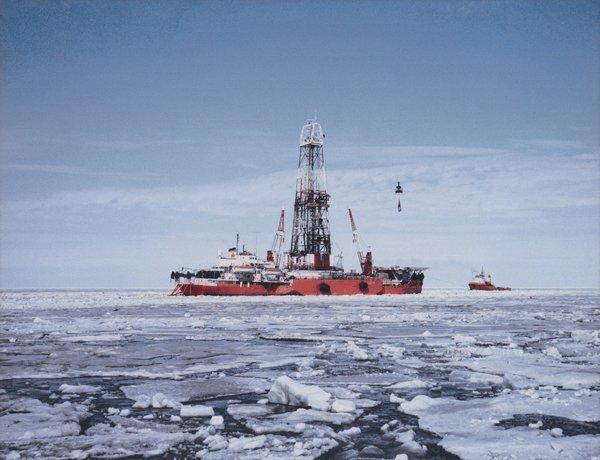
SHELL NEEDS ARCTIC

Royal Dutch Shell PLC is days away from drilling in the Arctic Ocean—betting it can find enough oil to justify the huge risks that keep almost every other competitor out of those icy waters.
The company is hauling two massive rigs—the Polar Pioneer and the Noble Discoverer—more than 2,000 miles up and around the Alaska coast to the Chukchi Sea, where it plans to begin work the third week of July. Accompanying the rigs are 30 support vessels and seven aircraft, a large entourage even by big oil-company standards.
The voyage represents Shell's effort to mount a comeback in the Arctic three years after a different rig ran aground following an unsuccessful drilling season. This time, Shell executives say they have both costs and safety under control, but the project has already hit a snag.
A federal agency said last week that Shell can't drill wells simultaneously within a 15-mile radius to minimize impacts on walruses, which means the company may only be able to drill one well this year instead of the two it had planned. And on Tuesday, Shell said that it discovered a small breach in the hull of a vessel carrying equipment for spill response and is examining what repairs are necessary.
A Shell spokesman said the company has modified its plans based on the new drilling requirement. It doesn't expect the damaged vessel to affect those plans, but "the answer will ultimately depend on the extent of the repairs," the spokesman said.
Overcoming such challenges has a huge potential reward: Alaska's portion of the Chukchi could hold the equivalent of 29 billion barrels of oil and gas, according to the U.S. Bureau of Ocean Energy Management. That is more than twice the global reserves that Shell can currently pump at a profit.
The Arctic is a prize that Shell competitors like Exxon Mobil Corp. and Chevron Corp. aren't pursuing for reasons ranging from collapsed oil prices to Western sanctions against Moscow. Even state-controlled giants like Russia's OAO Rosneft have put Arctic plans on hold this year. And a consortium including Exxon and BP PLC suspended its Canadian Arctic exploration program on June 26, saying it wouldn't be able to complete its work before its lease expires in 2020.
It could be a year or more before Shell knows whether it is sitting on a bonanza of crude or drilling one of the most expensive duds in history. Anything less than a blockbuster would be a significant setback for the company, Shell executives say, and a blow to oil development in the U.S. Arctic.
"Everybody's watching to see if we're going to fail or succeed out there," said Ann Pickard, an executive vice president who runs Shell's Arctic division. "If we fail for whatever reason...I think the U.S. is another 25 years" away from developing Arctic resources.
Ms. Pickard said that if the company fails to turn up oil in its best prospect, a drilling area called Burger-J, "I would probably recommend that we walk away."
The feasibility of producing oil in the Arctic will also be tested by Italy's Eni SpA and Norway's Statoil ASA. The two companies are moving into production this summer on Norway's Goliat field in the Barents Sea, 15 years after it was discovered.
The decision to push forward in the Arctic comes at a tumultuous moment for Shell. The Anglo-Dutch giant is struggling to tame costs as its cash flow is drained by low oil prices. It is moving forward with its largest-ever acquisition, a $70 billion takeover of rival BG Group PLC. And after years of pursuing natural gas as a cleaner-burning fuel, Shell is again a target of environmentalists who fear Arctic drilling could cause an ecological calamity.
Shell has already spent $6 billion on the Arctic and will sink over $1 billion more to drill in the Chukchi this year—if ice, storms and legal challenges don't derail its progress.
Some investors are leery of the Arctic and would rather see Shell focus on the prospects it acquired from BG.
"It feels like there are better alternatives elsewhere," said Jags Walia, oil-and-gas portfolio manager at Dutch pension-fund manager APG Asset Management, which owns Shell stock.
But the Arctic's untapped petroleum has a powerful allure. Shell must constantly find new sources of oil and gas to make up for wells that naturally decline. Last year the company discovered about a quarter as much oil and gas as it pumped, a rate that wouldn't sustain its output. A discovery in the Chukchi could bolster reserves through the next decade.
Shell has prospected for oil in Alaska's Arctic since the late 1980s but began its most recent push in 2005, as technology and melting ice caps have made the region more accessible. The U.S. Geological Survey says the Arctic's continental shelves may hold the largest remaining untapped oil reserves on earth.
If Shell finds oil, it would take at least another decade to build the necessary infrastructure to pump it. Shell executives said the costs, while high, were in line with other challenging projects such as its deep-water exploration.
Some of Shell's biggest investments in recent years haven't worked out as planned. It has suffered delays and cost increases in projects from Australia to Kazakhstan. The company has written off billions from its shale acreage in North America. And on its last voyage to Alaska's Arctic in 2012, a crew had to be helicoptered to safety by the U.S. Coast Guard, and a rig was scrapped after it ran aground.
The 2012 drilling campaign was troubled from the beginning. Shell got a late start because of thick ice conditions, had to halt drilling to dodge an iceberg and then suspended efforts after a spill-response system was damaged during a test. On the return voyage, the company misjudged the turbulence of the seas as it weathered 35-foot swells and 70-mile-an-hour winds.
"I believe that this length of tow, at this time of year, in this location, with our current routing guarantees an ass kicking," the top official of the towing vessel wrote in a Dec. 22, 2012 email, according to federal records. Over the next nine days, the towing vessel's engines failed, the lines attached to the Kulluk drilling rig broke and the rig ran aground on Dec. 31.
Shell Chief Executive Ben van Beurden has said the company has managed the risks down to "negligible" levels. It has replaced the scrapped Kulluk with the Pioneer, an eight-legged platform with steam-heated walkways and a derrick swaddled in sheets of metal insulation. It has hired more support vessels and aircraft, including two ships to tow the Pioneer. And it has tightened oversight of its contractors, which executives say is the most significant change since 2012.
Environmental groups last month challenged the U.S. Interior Department's approval of Shell's drilling plans. The company won a court order in May against Greenpeace, creating a buffer zone around its vessels to stop activists from boarding them, but the litigation is continuing. In Seattle, where the Polar Pioneer rig was docked until mid June, activists organized a flotilla of kayaks to protest.
"The Arctic Ocean is severely struggling with climate change. It's a disaster. Drilling will simply add additional impacts and risks of a spill," said Richard Steiner, a conservation biologist who taught at the University of Alaska and now works as a consultant.
Shell is relying on industry veterans like Doug Sloan, an Alaskan who spent years working on the North Slope—but never offshore in the Arctic. Mr. Sloan, a senior drilling supervisor who oversees 100 workers on the Pioneer, said he tries to cultivate a sense of "chronic unease.''
"You don't want to let your guard down," he said.
wsj.com
More:



